Discovering Crabtree Falls: A Hidden Gem of the Blue Ridge
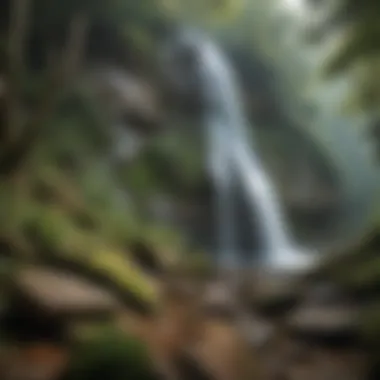
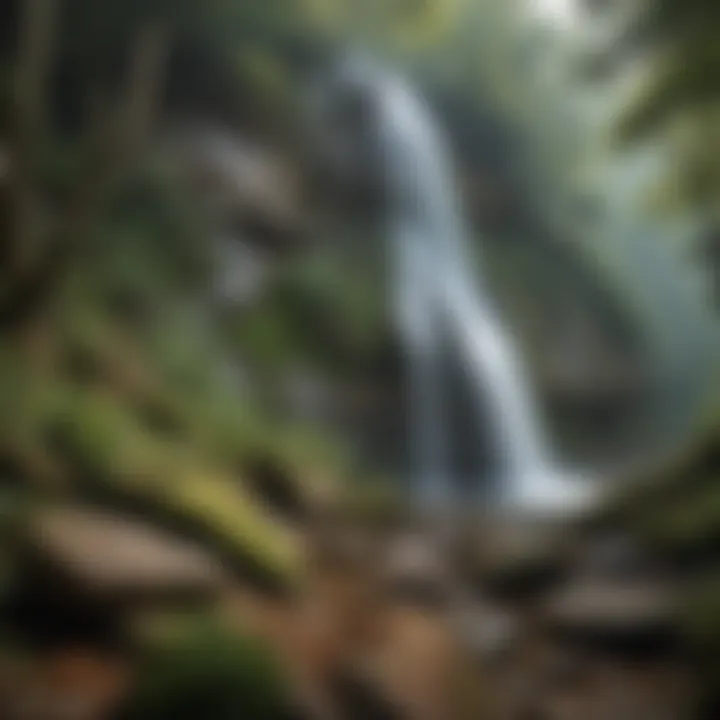
Intro
Nestled within the lush landscapes of the Blue Ridge Parkway, Crabtree Falls stands as a testament to the majestic beauty of nature. This waterfall is not just a visual spectacle; it serves as a vital part of the surrounding woodland ecosystem, contributing to its vibrancy and biodiversity. Visitors seeking both adventure and tranquility often make their way here, drawn by the allure of cascading waters and the rich flora that envelops the area. As we delve deeper into this natural wonder, it is essential to not only appreciate its aesthetic appeal but also understand its ecological significance and the impact of tourism on the environment.
Crabtree Falls provides a unique opportunity to explore the interactions between human activity and nature. This article aims to navigate through the various facets of the falls—from its stunning features and the recreational opportunities it presents to the broader environmental context that underscores the importance of sustainability in forestry practices.
Understanding Woodland Ecosystems
The surrounding forests of Crabtree Falls are rich ecosystems, teeming with life and complexity. These woodland ecosystems provide crucial habitat for numerous species, embodying rich biodiversity that is both delicate and resilient.
Importance of Biodiversity in Forests
Biodiversity within forests is akin to a web, where each thread plays a critical role in maintaining the overall structure and function of the ecosystem. Healthy forests offer numerous benefits, including:
- Habitat: They provide shelter and food for a wide array of wildlife, from the smallest insects to larger mammals.
- Genetic Variety: Diverse plant and animal populations enhance adaptability to diseases and environmental changes.
- Ecosystem Services: These include carbon sequestration, water purification, and soil fertility.
Role of Forests in Climate Regulation
Forests are often seen as the lungs of the planet. Their role in climate regulation cannot be overstated. They act as significant carbon sinks, absorbing carbon dioxide during photosynthesis and thus mitigating climate change impacts.
Moreover:
- Forests help stabilize the climate by moderating temperatures.
- They influence local weather patterns, enhancing rainfall and protecting against droughts.
The health of forest ecosystems directly correlates to global environmental stability, illustrating the necessity for conscious conservation efforts.
Crabtree Falls, with its breathtaking vistas, invites both a physical and a philosophical journey through these remarkable woodland ecosystems. As we continue our exploration of this area, it becomes clear that the beauty found here is intertwined with vital natural processes and responsibilities.
Prolusion to Crabtree Falls
Crabtree Falls is not just a waterfall; it’s a captivating blend of nature’s artistry and geological history situated within the majestic landscape of the Blue Ridge Parkway. This section introduces the reader to the multifaceted significance of Crabtree Falls and its contribution to both natural beauty and recreational allure. As one of the most scenic waterfalls in Virginia, it draws in enthusiasts not only for its breathtaking views but also for the myriad of activities that accompany such a striking feature. Whether one is an avid hiker, a casual visitor, or a budding photographer, Crabtree Falls offers something for everyone, making it a pivotal destination along the parkway.
Location and Accessibility
Positioned at an elevation that grants it a prominent view of the surrounding wilderness, Crabtree Falls is easily accessible via the Parkway itself. To visit, one simply needs to follow the trails that connect to the falls, with the most popular route starting from the Crabtree Falls Picnic Area. The journey from the parking area to the falls is approximately a mile with a slightly rugged path, but it is accessible to most visitors who are equipped with decent footwear.
For those relying on longer trips, it is advisable to plan ahead, especially during the peak tourist seasons when foot traffic increases. Local signage will guide you, and it's almost impossible to miss the soft roar of the waters cascading down the rocks as you get closer.
Historical Significance
Crabtree Falls is steeped in a rich tapestry of history that dates back to early European settlers who admired its splendor. It once served as a landmark for travelers making their way through the Blue Ridge region. Additionally, the area surrounding the falls has historical significance related to local mountain communities, who relied on these natural resources.
The waterfall's name is believed to have originated from the Crabtree family, early settlers who lived nearby in the 18th century. Today, the falls are more than a stunning natural feature; they embody a piece of Appalachian heritage that speaks to the relationship between people and nature throughout the ages. As visitors stroll around, the echoes of the past linger in the air, urging them to reflect on the land’s storied relevance while enjoying its present beauty.
Geological Features of Crabtree Falls
Understanding the geological features of Crabtree Falls is fundamental in appreciating not just its grandeur, but also the story it tells about the landscape and processes that shaped it. These features intertwine with the natural history and present ecosystem, showcasing a dynamic interplay between the physical and biological worlds. This exploration of geological formations goes beyond mere rocks and waterfalls; it delves into the heart of how these elements influence biodiversity, water flow, and even human interaction with the environment.
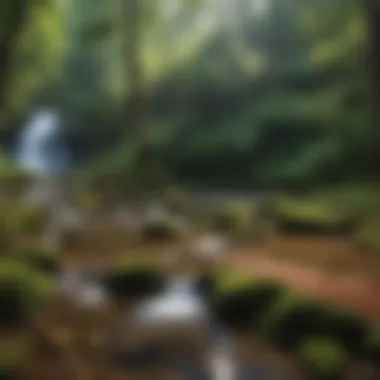
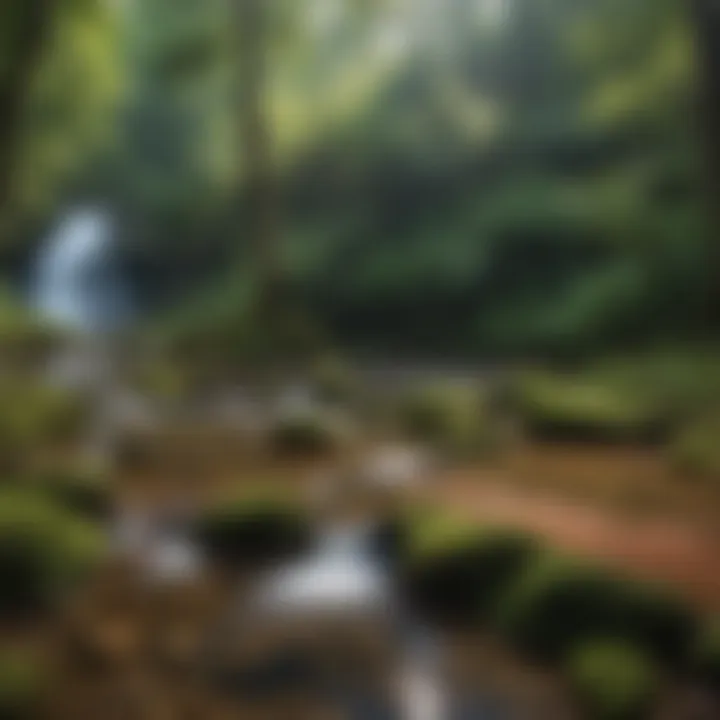
Formation of the Waterfall
Crabtree Falls stands as a testament to the relentless forces of nature. The waterfall is primarily the result of age-old glacial activity coupled with erosion over eons. During the last Ice Age, glaciers carved out the rugged terrain that we now know. As these massive ice formations retreated, they exposed the underlying rock structures, setting the stage for the waterfall to develop.
Water cascades down about 1,200 feet, appearing both as a series of drops and pure flow as it navigates rocky surfaces. The flow is largely fed by seasonal rains and melting snows, making the waterfall’s presence even more captivating during spring. It's this ever-changing volume of water that defines not only the appearance of the falls but also the ecosystem supported below.
"The beauty of Crabtree Falls is not static; it evolves with every drop of water that descends, intricately weaving into the fabric of its environment."
Rock Types and Composition
Crabtree Falls is bordered and supported by a series of rock types that contribute to its beauty and stability. The primary rock here is granite, which often leads to a robust formation, known for its weather resistance. Intrusions of metamorphic rock further enhance the geological diversity, highlighting a complex history of temperature and pressure changes through time.
Different layers of rock tell the tale of ancient geological events. The granite has stood the test of time, while softer sedimentary layers have eroded to create the features we see today. This dynamic contrast not only shapes the physical landscape but also creates varied habitats along the banks, supporting different species of flora and fauna.
Erosion and Landscape Development
Erosion has played a vital role in sculpting the present landscape around Crabtree Falls. Rain, wind, and ice constantly work to wear down the rocky surfaces. It’s a slow but relentless process that gradually reshapes the mountain, creating new pathways for water while redirecting the flow to carve deeper gorges and pools.
The result is a constantly evolving environment. Over time, the waterfall has changed its shape and position due to sediment deposits and shifts in the underlying rock. It's an ongoing dance between stability and change, making the area an intriguing study for geologists and environmentalists alike.
The landscape development is not solely due to natural forces; human activity also shapes the region. Increased traffic and tourism has led to some changes. Understanding these interactions is crucial for preserving the integrity of the area and guiding future conservation efforts.
Through continuous observation and study of Crabtree Falls’ geological features, we glean deeper insights into the ecological systems it supports, which are vital for sustaining the delicate balance of nature.
Ecological Importance
The ecological significance of Crabtree Falls goes beyond its sheer beauty; it represents a vital component within the broader Blue Ridge ecosystem. The waterfall itself plays a critical role in shaping local habitats and, in doing so, contributes to a larger narrative of natural balance. In this section, the importance of Crabtree Falls as an ecological bastion will be unpacked, shedding light on the myriad ways in which it supports biodiversity and interacts with its environment.
Biodiversity in the Area
Crabtree Falls is not just a pretty face in the landscape; it's a hotspot for biodiversity. The area is home to a multitude of species that rely on its unique microhabitats. From various bird species singing a chorus in the treetops to the myriad of insects that buzz and flitter about, biodiversity flourishes here.
- Birds: The falls serve as a nesting ground for species like the Black-capped Chickadee and the Rose-breasted Grosbeak. Their songs create a rich auditory tapestry that is both calming and invigorating.
- Insects: The microclimates created by the cool, moist air around the falls provide perfect conditions for a range of pollinators. Butterflies flutter through wildflowers, while bees work tirelessly to gather nectar.
- Aquatic Life: The streams that feed the falls are home to insects like mayflies and stoneflies, forming a crucial food web that supports larger aquatic species.
Role of Waterfalls in Ecosystems
Waterfalls, like Crabtree Falls, contribute to ecosystems in profound ways. They not only beautify the landscape but act as essential agents for ecological processes. Here are a few facets of their role:
- Water Filtration: The movement of water over rocks helps to filter out pollutants, improving water quality as it travels downstream.
- Nutrient Cycling: As water cascades, it erodes rocks, releasing minerals back into the stream. This natural process enriches the ecosystem, promoting vegetation growth.
- Habitat Creation: The varying velocities of water around the falls create distinct habitats; fast-moving water supports certain life forms while calmer pools offer shelter to others. This dynamic environment nurtures a wide array of species, enhancing overall ecosystem resilience.
Flora and Fauna Specific to the Region
The region surrounding Crabtree Falls is teeming with a spectacular array of flora and fauna that thrive in its unique microenvironment. Each species plays its part in this intricate tapestry of life.
- Dominant Plant Life: The forested area is predominantly made up of deciduous trees like oak, cherry, and maple, which display a stunning palette of colors in fall. Various understory plants, such as ferns and wildflowers, add to the lushness, creating different layers of vegetation that supports diverse wildlife.
- Endemic Species: Some species are endemic to the region, meaning they can only be found here. For instance, certain rare orchids bloom in the damp, shaded areas close to the waterfall. These plants, although small, have massive implications for conservation and ecological health.
- Wildlife Interactions: The variety of habitats—created by changes in elevation and moisture—means that many animals find food and shelter here. From the elusive bobcat prowling through the underbrush to deer grazing nearby, the interaction between different species fosters stability in the ecosystem.
"The intricate relationships among species within the ecosystem testify to the importance of preserving environments like Crabtree Falls. Every creature, no matter how small, has a role to play."
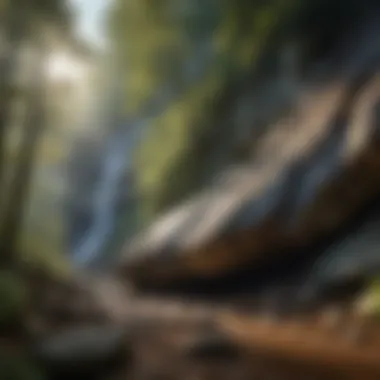
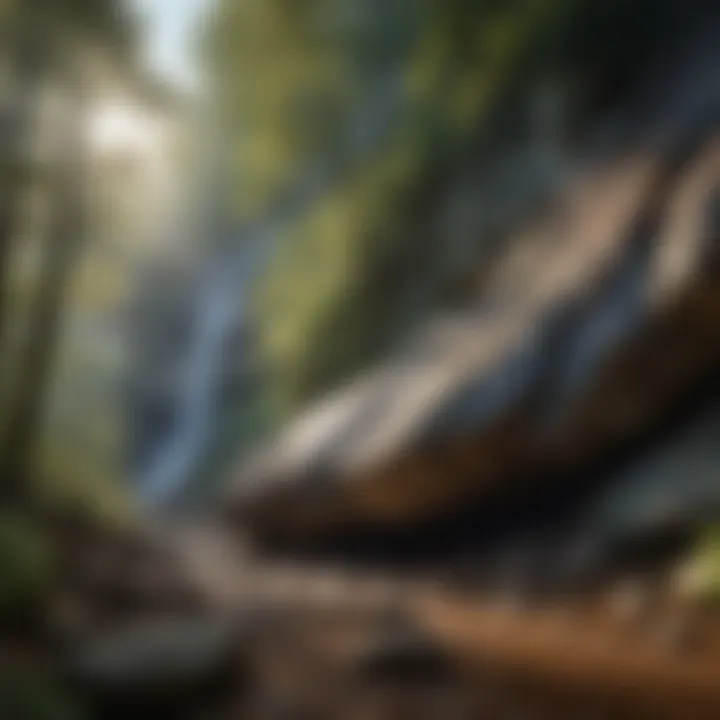
Visitor Experience at Crabtree Falls
Visiting Crabtree Falls is not just about standing in front of a magnificent waterfall. It's an experience that intertwines nature, adventure, and personal reflection. The significance of this topic lies in how visitors can connect with the environment, find joy in outdoor activities, and also play a part in conserving this natural jewel. Understanding the particular elements of the visit elevates the experience and fosters a sense of responsibility for protection efforts. As more people flock to beautiful destinations, awareness around these aspects becomes paramount.
Hiking Trails and Routes
The pathways that lead to Crabtree Falls are as noteworthy as the falls themselves. The Crabtree Falls Trail stretches roughly 1.5 miles, winding its way through a lush forest and providing ample opportunities to engage with the local flora and fauna. This trail caters to various skill levels, making it accessible for families and seasoned hikers alike. The trail also features several switchbacks, which not only enhance the hiking experience but also offer beautiful vistas en route.
One significant aspect of the trail is the elevation gain of about 800 feet. This hike is somewhat steep but totally worth it when you hear the rush of water as you approach the falls. To ensure safety, walkers should wear sturdy shoes and bring adequate water supplies. In the summer, the trail can get crowded, so starting early in the morning can help in enjoying some quiet moments before the influx of visitors.
"Taking a moment to meditate by the water’s edge can bring clarity that often feels elusive in everyday life."
Viewing Platforms and Best Practices
Once arrivals reach the falls, the designated viewing platforms offer the best sights. These platforms are strategically placed to maximize the waterfall's grandeur while minimizing wear on the surrounding environment. It's essential for visitors to stay within these borders, as venturing beyond them can lead to erosion and other ecological disturbances. Depending on the time of year, the flow of water can change, leading to varying experiences of what the falls look like.
Practicing responsible tourism also includes leaving no trace. Visitors should remain mindful of their personal belongings and ensure that no trash is left behind. Additionally, social media enthusiasts will appreciate that early morning light or late afternoon sunlight offers the most captivating views. Planning around these times ensures not just quality photographs but also a peaceful experience.
Photography Tips and Scenic Views
Capturing the beauty of Crabtree Falls poses both a challenge and an opportunity for photographers. The mist created by the waterfall uniquely interacts with sunlight, creating spectacular rainbows if conditions are just right. Here are some tips for maximizing photography prospects:
- Use a tripod: Stability is crucial when shooting in low light conditions. A tripod helps keep your camera still, allowing for longer exposures if desired.
- Experiment with angles: Step back to capture the entire falls. Zooming in on details like flowing water or vibrant flora can yield stunning images.
- Consider the weather: Overcast days can create soft light, ideal for capturing the nuances of the landscape. But a sunny day brings out different colors.
- Include foreground elements: Rocks or plants at the base can provide context and depth to your photographs.
Overall, a visit to Crabtree Falls can easily become a memorable experience if one takes the time to appreciate its natural beauty and adhere to the principles of conservation. Each element of the visit—whether hiking, observing, or capturing—reinforces the importance of this spectacular place in the Blue Ridge Parkway.
Conservation Efforts at Crabtree Falls
Crabtree Falls is not just a feast for the eyes but also a critical natural resource that requires vigilant conservation efforts. The delicate balance of this ecosystem, combined with the increasing number of visitors, makes the topic of conservation pivotal. Safeguarding Crabtree Falls ensures its beauty and the surrounding biodiversity can be preserved for generations down the line. Let’s unpack this in detail.
Impact of Tourism on the Surrounding Environment
Tourism has a double-edged sword effect on Crabtree Falls. On one hand, the influx of visitors boosts local economies and promotes awareness of natural wonders. However, on the flip side, increased foot traffic can lead to soil erosion, littering, and wildlife disturbances. As more people traverse the trails, the potential for damaging delicate flora and fauna grows.
- Soil Erosion: Excessive foot traffic, especially during wet seasons, can compact soil and lead to runoff, which erodes the land surrounding the falls.
- Litter and Waste: Despite efforts from authorities and organizations, litter still finds its way into this pristine environment, impacting the aesthetic and ecological quality of the area.
- Wildlife Disturbance: Species that rely on natural habitats may be driven away due to increased noise and human activity.
Understanding these impacts is essential for crafting effective conservation strategies that minimize damage while promoting sustainable tourism practices.
Local Initiatives for Preservation
There's no shortage of local initiatives aimed at preserving the integrity of Crabtree Falls. These efforts are spearheaded by community groups, local government bodies, and conservation organizations that understand the delicate fabric of this rich ecosystem.
- Education Programs: Many organizations focus on educating visitors about the ecological importance of the falls. Workshops and interpretive guides often highlight the local climate, wildlife, and plant species, fostering a sense of stewardship among tourists.
- Volunteering Events: Regular community clean-up events engage locals and visitors alike in hands-on conservation work. Whether it’s picking up trash or planting native species, every little bit helps.
- Trail Maintenance: Local groups are dedicated to maintaining the trails. They often work to reinforce pathways with natural materials to reduce erosion and enhance the trail experience.
These initiatives not only look after the physical aspects of conservation but also build a community ethos centered around environmental responsibility.
Visitor Responsibilities in Conservation
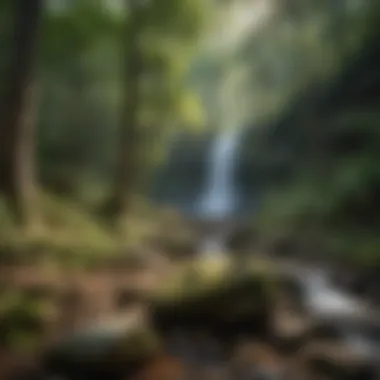
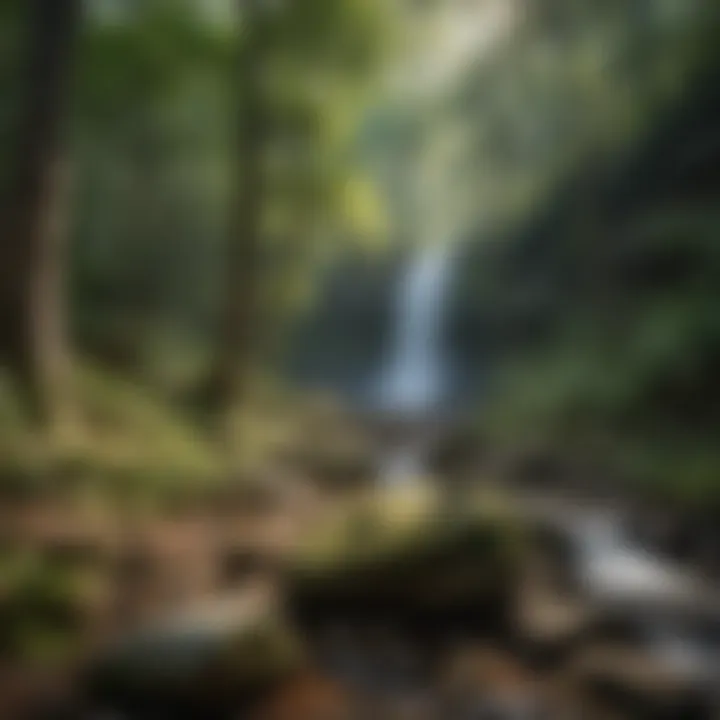
While conservation efforts are often led by dedicated organizations and locals, visitors also play an essential role. Being responsible and conscious of one’s impact can make a significant difference in preserving Crabtree Falls. Here are simple yet effective practices:
- Leave No Trace: This principle encourages everyone to take their trash with them. Additionally, sticking to marked trails helps to minimize environmental disruption.
- Respect Wildlife: Observing animals from a distance ensures their natural behaviors aren’t disrupted. Feeding wildlife can lead to serious health problems for animals and alter their natural habitats.
- Participate in Conservation Activities: Engaging in local initiatives, such as clean-up days or educational sessions, not only helps preserve the area but also deepens your connection to it.
"A journey through nature is never simply an adventure; it’s a responsibility we hold to ensure its beauty endures."
In summary, the conservation of Crabtree Falls is a multifaceted approach involving balanced tourism practices, spirited local initiatives, and active visitor participation. Only through mindful actions can we preserve this jewel of the Blue Ridge Parkway and ensure it remains a thriving ecosystem for future generations.
The Role of the Blue Ridge Parkway
The Blue Ridge Parkway is more than just a scenic byway; it's a portal that connects diverse ecosystems, rich history, and cultural heritage. Encompassing stretches of breathtaking landscapes, the parkway provides an unparalleled approach to experiencing the natural beauty and ecological significance of areas like Crabtree Falls. Its role not only enhances visitor engagement but also contributes to conservation efforts and public awareness surrounding natural wonders.
Historical Context of the Parkway
The Blue Ridge Parkway was conceived during the Great Depression as part of President Franklin D. Roosevelt's New Deal program. Its creation was aimed at providing jobs while allowing the public to engage with nature, fostering a spirit of conservation at a time when such ideals were taking root across the country. Spanning over 469 miles, the parkway was completed in 1987 and has since been a symbol of America’s national heritage, connecting the Great Smoky Mountains National Park to Shenandoah National Park. The parkway's design, guided by the principles of the American Landscape Movement, utilizes the natural terrain to create a seamless experience that accentuates the beauty of various natural features, including the enchanting Crabtree Falls.
Cultural Significance of Natural Attractions
Natural attractions along the Blue Ridge Parkway are steeped in cultural significance. Crabtree Falls, with its cascading water and vibrant flora, draws not only nature enthusiasts but also artists, poets, and historians, fostering a sense of connection between human creativity and the environment. The diversity of visitors—families, scholars, and outdoor adventurers—reflects a growing appreciation for the intersection of culture and nature. As people gather to appreciate these sites, they also share stories and traditions, thus weaving a cultural tapestry that honors the land. This symbiotic relationship underscores the need for sustainable tourism practices to ensure future generations can enjoy these treasures.
Connectivity of Landscapes in the Region
The Blue Ridge Parkway stands out for its ability to interconnect various landscapes, creating corridors for both wildlife and human exploration. The close proximity of walking trails, like those leading to Crabtree Falls, encourages outdoor activities while promoting biodiversity. Each viewpoint along the parkway serves as a spotlight on the diverse ecosystems, ranging from dense forests to open meadows. This network of trails and scenic overlooks challenges visitors to appreciate not just the individual beauty of locations like Crabtree Falls but also their roles as components of a larger ecological system. As you traverse the parkway, it becomes evident that every tree, rock formation, and trickling stream is part of a cohesive narrative of preservation and discovery.
"The Blue Ridge Parkway serves as a living testament to the deep connection between nature and cultural identity, inviting visitors to explore and appreciate its beauty while respecting its fragility."
In totality, the Blue Ridge Parkway enhances the experience at Crabtree Falls, multiplying the joys and educational opportunities for those who wander its paths. From its historical foundations to its cultural impact, the parkway elevates how we engage with and understand our natural environment.
Finale
In this exploration of Crabtree Falls, we've uncovered layers of significance that extend beyond mere aesthetic appeal. Understanding Crabtree Falls is essential not just for appreciating its beauty but also for recognizing its ecological and cultural relevance in the context of the Blue Ridge Parkway. This region is not just a collection of sites, but a living environment that connects the past with the present, emphasizing a narrative of preservation and respect.
Summarizing the Experience
Visitors often find themselves captivated by the graceful descent of water over rocks and the calming sounds that accompany such a natural spectacle. Crabtree Falls offers more than just a place to enjoy the visual feast; it serves as an opportunity to reflect on the complex interplay between humans and nature. The experience of hiking the trails and standing at various viewpoints allows individuals to immerse in a landscape that tells a story of resilience and continuity.
Through easy access to hiking trails, informative signs, and ample viewing platforms, anyone can engage with the falls in a meaningful way. Furthermore, the chance to spot unique flora and fauna adds layers to the experience, highlighting the area's biodiversity.
Future Perspectives on Conservation
Looking ahead, the future of Crabtree Falls hinges on the balance between human enjoyment and ecological preservation. As tourism continues to grow, so does the need for sustainable practices. It is imperative to remember that with every footstep taken along the trails, we must tread lightly.
Key considerations for conservation moving forward include:
- Visitor Education: Initiatives aimed at educating visitors about the ecosystems at play, including potential impacts on local wildlife.
- Sustainable Infrastructure: Developing infrastructure that supports tourists while minimizing environmental disruption—like eco-friendly paths and visitor centers.
- Active Participation: Encouraging visitors to engage in conservation efforts, such as volunteering for clean-up days or participating in local wildlife surveys.
"Nature does not hurry, yet everything is accomplished." — Lao Tzu
This sentiment encapsulates the philosophy required in safeguarding Crabtree Falls and its surroundings. By fostering a sense of shared responsibility among visitors and locals alike, it opens up pathways for collective action in nature conservation.
Ultimately, the beauty of Crabtree Falls is a reminder of what is at stake: not just a waterfall, but an entire ecosystem that thrives on our respect and care. By practicing thoughtful tourism, we can ensure that this gem of the Blue Ridge Parkway remains unspoiled for generations to come.
For those eager to learn more, resources like Wikipedia, Britannica, or community discussions on Reddit offer invaluable insights into ongoing conservation efforts and engagement opportunities.
As we conclude, it’s essential to carry forth the understanding that every visit contributes to the larger narrative of sustainability and respect towards the natural world. Together, we can help maintain the wonder that draws many to distinguished locations like Crabtree Falls.







